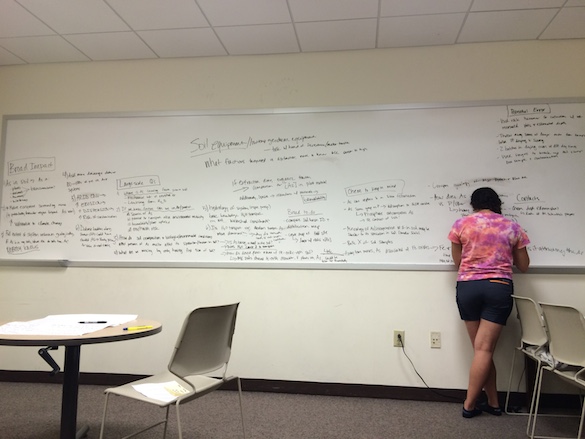San Diego, CA – Thinking like a scientist is a challenging and important learning goal for the Wooster Geologists, and one of the primary reasons that we engage our students in undergraduate research. Although science is often portrayed as a collection of facts or as a series of exercises designed to prove something that is already known, our research students learn that science is a way of thinking. It is a method of inquiry that involves creativity, examining a question from multiple perspectives, and understanding uncertainty. Science requires hypotheses that are testable, data that can be collected and interpreted, and explanations that are supported by evidence. Today, our Black Mountain research group focused on these aspects of science as we developed our research goals and plans for the rest of the summer.

Amineh AlBashaireh (’18) filled the whiteboard with an impressive set of ideas and questions to prompt our research discussion. On the left are “broad impacts” that define the significance of the research and put the research into context of the larger society. On the right are sources of “potential error,” which Amineh is recognizing and attempting to minimize.
Eventually, we developed a couple of research questions that Amineh will be able to address this summer. We formulated hypotheses for the answers to these questions and designed a research strategy that will generate the data necessary for testing our hypotheses. In the end, we created a research plan that is both achievable (given the constraints of time, expertise, resources, etc.) and flexible enough to allow the research to evolve as Amineh discovers new findings and develops new questions.
For an excellent resource on the process of science, check out the Visionlearning module by Anthony Carpi and Anne Egger. It’s an incredible resource for teachers and students alike.
References:
Carpi, A., and Egger, A.E. 2009. The process of science. Visionlearning POS-2 (8).



Classic mentored research, with all the modern innovations.
I absolutely love this, Dr. Pollock! Thank you for sneakily watching me as I frantically scribbled ideas down. You’ve really helped me see things from your perspective as well as Beth’s. I’ll try to be unattached in my excitement as we move forward!
Great post – looking forward to hearing more about the project. Thanks for the “science process” resource, Dr. Pollock.